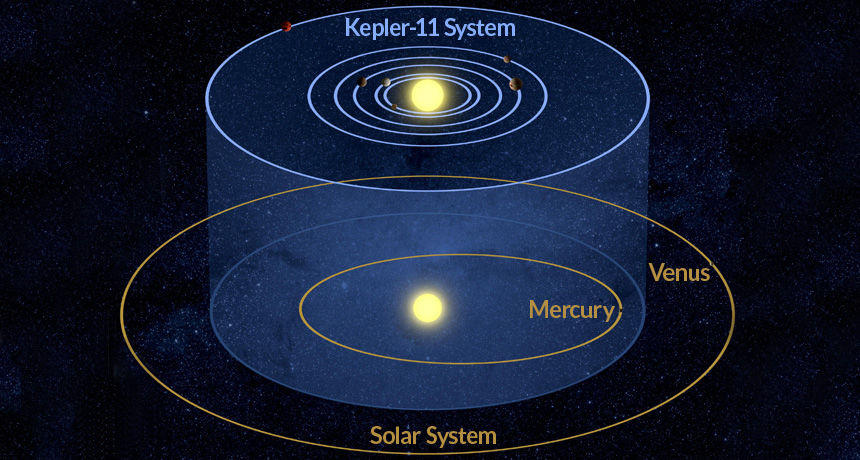Earth, neighbors weren’t the first rocky planets in the solar system
A wandering Jupiter helped push an early generation into the sun, new study claims

FIRST DRAFT The solar system may have once hosted several large rocky planets close to the sun, like Kepler 11 (illustrated) does, before Jupiter swept them away.
Tim Pyle/NASA
- More than 2 years ago
Earth and its neighbors aren’t the first rocky planets to circle the sun, a new study suggests. Jupiter might have had a hand in flushing an earlier generation of rocky worlds into the sun to their doom, clearing the way for the current planets to form.
A rain of asteroids hurled into the inner solar system by a wandering Jupiter could have swept up a family of large rocky planets huddled up close to the sun, researchers report online March 23 in the Proceedings of the National Academy of Sciences. The planetary cleanse would have left behind a narrow ring of debris out of which Mercury, Venus, Earth and Mars formed. Such a scenario could explain why the solar system stands out from other planet families with its lack of oversized rocky worlds hugging the sun.
“We’re not a truly one-of-a-kind solar system,” says Konstantin Batygin, a planetary scientist at Caltech, “but I think that we belong to a minority.” What sets us apart, he says, is that we have giant gas planets, which are relatively rare around other stars.
The inward migration of Jupiter and Saturn has been used to explain the small size of Mars, the current arrangement of the asteroid belt and the delivery of water to Earth (SN: 5/5/12, p. 24). Jupiter might have wandered in as close as the current orbit of Mars before being yanked back out by Saturn’s gravity when the ringed planet caught up to it. The close approach of Jupiter would have carved an outer edge in the disk out of which the current rocky planets formed, starving future Mars of material it needed to grow larger. Batygin now suggests Jupiter’s travels also helped clear out an inner edge as well.
Batygin, along with astronomer Gregory Laughlin of the University of California, Santa Cruz, ran computer simulations to see what would happen if the inner solar system once resembled Kepler 11, where five large, rocky planets circle within an orbit similar to Mercury’s. In the simulation, Jupiter sweeps up asteroids as it wanders. The asteroids smash together in the inner solar system, leaving behind an obstacle course of boulders. As the boulders spiral inward, they gravitationally snag the planets and drag them into the sun. Over time, the inner solar system is almost stripped clean, leaving a large gap where the first generation of planets lived.
Shoving planets into the sun might not be that simple, though. “I love that people are thinking about this stuff,” says Sean Raymond, an astrophysicist at the University of Bordeaux in France, but he sees a couple of red flags. He agrees that incoming asteroids would smash together and create a sea of boulders. But the debris, he says, tend to help planets grow, rather than nudge them out of their orbits.
He also wonders how the planets could fall into the sun. The disks of gas and dust that circle a young star don’t touch the surface of the star. The star’s magnetic field forms a gap in the disk that planets can’t cross, he says.
Batygin and Laughlin say they have a way to test their hypothesis: If they’re right, then planetary systems with giant gas planets should not have close-in super-Earths, and vice versa. Raymond notes, however, that such a finding could be interpreted in another way. Batygin and Laughlin assume that super-Earths form where we see them. If they instead start far from their stars and wander in later, a gas giant like Jupiter could act as a barrier. Batygin and Laughlin’s test can’t distinguish between these two outcomes, Raymond says.
If there is any sort of link between super-Earths and gas giants, the revived Kepler space telescope, dubbed K2, could provide some hints, Batygin says. But the real test will come when the Transiting Exoplanet Survey Satellite, or TESS, launches in 2017. TESS will search the closest stars for exoplanets which, because of their proximity to Earth, can then easily be studied using telescopes on the ground.







